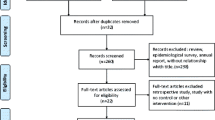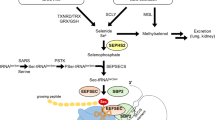Abstract
Kashin-Beck disease (KBD) is an endemic, degenerative osteoarthropathy, and particularly seen in China. A deficiency of selenium and iodine is implicated as the main etiological factor for KBD. This meta-analysis aimed to evaluate the differences in the selenium and iodine levels between patients with KBD and healthy individuals. Eligible articles published before March 6, 2015 were searched from four electronic databases. Data extraction and quality assessment of included studies were performed by two independent reviewers. Results were summarized as standardized mean difference (SMD) with 95 % confidence intervals (CIs). Cohen’s d test was used to estimate the difference of the effect size between patients with KBD and healthy controls. A total of 26 cross-sectional studies were included in the meta-analysis. The pooled SMD showed that the whole blood selenium (Cohen’s d = 4.39, P < 0.001), serum selenium (Cohen’s d = 2.42, P = 0.015), hair selenium (Cohen’s d = 5.46, P < 0.001), and urinary selenium (Cohen’s d = 4.16, P < 0.001) levels were significantly lower in patients with KBD than that in healthy controls. There was no significant difference of plasma selenium (Cohen’s d = 0.08, P = 0.936) and urinary iodine (Cohen’s d = 0.33, P = 0.744) levels between subjects with KBD and healthy controls. In conclusion, the levels of selenium, but not iodine were significantly lower in subjects with KBD than that in healthy controls. Selenium deficiency might be associated with the risk of KBD.







Similar content being viewed by others
References
Guo X (2001) Diagnostic, clinical and radiological characteristics of Kashin-Beck disease in Shaanxi Province, PR China. Int Orthop 25(3):147–150
China health statistics yearbook 2013. National Health and Family Planning Commission of the PRC Web. http://wwwnhfpcgovcn/htmlfiles/zwgkzt/ptjnj/year2013/index2013html. Accessed 6 Feb 2015
Guo X, Ma WJ, Zhang F, Ren FL, Qu CJ, Lammi MJ (2014) Recent advances in the research of an endemic osteochondropathy in China: Kashin-Beck disease. Osteoarthr Cartil 22(11):1774–1783
Fairweather-Tait SJ, Bao Y, Broadley MR, Collings R, Ford D, Hesketh JE, Hurst R (2011) Selenium in human health and disease. Antioxid Redox Signal 14(7):1337–1383
Li Q, Zhao ZJ (2006) Prevalence state of Kashin-Beck disease in Qinghai Province—a retrospective analysis. Chinese J Endocrinol 06:675–677(in Chinese)
Ma T, Guo J, Wang F (1993) The epidemiology of iodine-deficiency diseases in China. Am J Clin Nutr 57(2 Suppl):264S–266S
Moreno-Reyes R, Suetens C, Mathieu F, Begaux F, Zhu D, Rivera MT, Boelaert M, Neve J, Perlmutter N, Vanderpas J (1998) Kashin-Beck osteoarthropathy in rural Tibet in relation to selenium and iodine status. N Engl J Med 339(16):1112–1120
Moher D, Liberati A, Tetzlaff J, Altman DG (2010) Preferred reporting items for systematic reviews and meta-analyses: the PRISMA statement. Int J Surg 8(5):336–341
Rostom A, Dubé C, Cranney A, Saloojee N, Sy R (2004) Celiac disease. AHRQ evidence reports. Rockville: Agency for Healthcare Research and Quality (US). http://www.ncbi.nlm.nih.gov/books/NBK35156/. Accessed 20 Jan 2015
Guan JY, Zhao YH, Li FS (1988) A study of erythrocyte selenium, glutathione peroxidase and urinary cAMP in children with Kaschin-Beck disease in Inner Mongolia. Chinese J Control Endem Dis 3(06):353–354(in Chinese)
He FL, Wang ZW, Ma XJ, Zhu DC, Yang JB (1989) Studies on 20 biochemical indices of children Kashin-Beck disease. Chinese J Control Endemic Dis 4(02):70–72(in Chinese)
Lv SM, Bai S, Zhang SY, Yu ZD, Xiong YM, Mo XY, Wang ZL, Ding DX, Tan XW (1991) Comparing analyses of selenium status in children with and without Kashin-Beck disease. Chinese J Control Endemic Dis 6(05):257–260(in Chinese)
Lv SM, Bai S, Wang ZL, Yu ZD, Zhang SY (1991) Elementary study on renal plasma clearances of selenium in children from Kashin-Beck disease affected areas. J Xi’an Jiaotong Univ (Medical Sciences) 12(02):137–138(in Chinese)
Li SC, Mo XY, Zhang SY, Yu ZD, Li YC (1992) Investigation on the relationship between urinary selenium and urinary excretion of hydroxyprohne and glyeosmainogylean in children with Kashin-Beek disease. Endem Dis Bull 7(02):73–76(in Chinese)
Zhang PY, Yang YX, Xu GL, Xue WL, Ge LL, Liang WS (1993) The relationship between erythrocyte immune function and blood selenium levels in Kaschin-Beck disease. Chinese J Endemiol 12(05):16–17(in Chinese)
Ding DX, Guo X, Yu ZD, Bai S (1994) A 1:1 matched case–control study in Kashin-Beck disease. J Xi’an Med Univ (Chinese Version) 15(01):95–96(in Chinese)
Mo XY, Li SC, Zhang SY, Yan TJ (1994) Study on disaccharides and components of glycosaminoglycan in children with Kashin-Beck disease. Chinese J Control Endemic Dis 9(04):197–199(in Chinese)
Mo XY, Zhang SY, Xue WL (1995) Comparative study on relationship between blood selenium and sulfhydryl groups in children with and without Kashin-Beck disease. Chinese J Endemiol 14(03):150–152(in Chinese)
Xu JM, Wu ML, Chen JH, Zhou XG, Wang GD, Wang J, Dang HX (1997) A study of relationship between iodine and Kashin-Beck disease. Chinese J Control of Endemic Dis 12(05):307–309(in Chinese)
Xiong YM, Bi HY, Wang ZL, Bai S, Yu ZD, Xue L, Geng D, Chen FS (1998) Determination of blood selenium, vitamin C and phosphorus in people from the co-existence of KBD and KSD areas and some special areas. Guangdong Trace Elements Science 5(10):18–21(in Chinese)
Yin XY, Xu X, Zhang WX, Kang BA, Zhou Q (1999) Determination of hair selenium in both Keshan disease and Kashin-Beck disease patients. Chinese J Endemiol 18(01):28–29(in Chinese)
Zhang W, Neve J, Xu J, Vanderpas J, Wang Z (2001) Selenium, iodine and fungal contamination in Yulin District (People’s Republic of China) endemic for Kashin-Beck disease. Int Orthop 25(3):188–190
Lu GL, Jin M, Lei SY (2004) Relationship between trace elements and clinical significance of Kashin-Beck disease in children. Chinese J Endemiol 23(06):88–91(in Chinese)
Zhao ZJ, Li Q, Wu HK, Zhang Q, Yu HZ, Liu XR (2005) A nutrition survey of selenium, iodine in children with and without Kashin-Beck disease in Qinghai Province. Qinghai Med J 08:64(in Chinese)
Kang LL, Xu P, Zhaxi SZ, Basang ZM, Li XY, Guo X (2006) The changes of hyaluronan, nitric oxide and selenium contents in serum for patients with Kashin-Beck disease in Tibet. Chinese J Endemiol 25(06):694–696(in Chinese)
Liu FS, Ma MZ, Lei CX, Wang HW, Zheng WZ, Yang YM, Zhao WB, Jie DG, Yang LL, Xiong LQ (2007) A survey report for Kashin-Beck disease from 2002 to 2003 in Tianshui, Gansu Province. Endemic Dis Bull 22(01):47–49(in Chinese)
Li XY, Guo X, Wang LX, Gend D, Kang LL, Wang S, Wang ZF, Gu QS (2007) Serum hyaluronic acid, tumor necrosis factor-α, vascular endothelial growth factor, NO, and Se levels in adult patients with Kashin-Beck disease. J Southern Med Univ 27(07):941–944(in Chinese)
Wang HY, Chen Z (2008) A case control study of hair trace element selenium levels in patients with Kashin-Beck Disease. Chinese J Control of Endemic Dis 23(01):59–60(in Chinese)
Zhai JM (2008) Studies on the relationship between Kaschin-Beck disease and hair selenium, urine iodine and food fungi toxin. Disseration, Jilin University. (in Chinese)
Fu Y, Meng FG, Deng JY, Fu XY, Huang H, Li DA, Wang LH (2010) Investigation on the selenium and T-2 toxin level in Kaschin-Beck disease relative active regions in Aba state of Sichuan Province in 2008. Chinese J Endemiol 29(3):325–329(in Chinese)
Lv AL, Guo X, Shi XW, Ren FL (2011) Association analysis between genetic polymorphism of 14 STR loci on chromosome 2 and Kashin-Beck disease. Chinese J Bone Joint Injury 26(09):796–798(in Chinese)
Shi Y, Lu F, Liu X, Wang Y, Huang L, Liu X, Long W, Lv B, Zhang K, Ma S, Lin H, Cheng J, Zhou B, Hu M, Deng J, Zhu J, Hao P, Yang X, Zeng M, Wang X, Shen S, Yang Z (2011) Genetic variants in the HLA-DRB1 gene are associated with Kashin-Beck disease in the Tibetan population. Arthritis Rheum 63(11):3408–3416
Zeng J, Deng JY, Li FZ, Chen J, Jian HB, Huang H, Chen KH, Qin SC (2013) A case–control study on Kashin-Beck disease-related factors in Aba of Sichuan Province. Chinese J Endemiol 32(5):548–551(in Chinese)
Tang X, Zhou ZK, Shen B, Kang PD, Yang J, Li J, Li Q, Pei FX (2013) Serum levels of selenium and fluorine in patients with adult Kashin-Beck disease. West China Med J 28(02):221–223(in Chinese)
Ci Y, Yang Z, Basang ZM, Xirao RD, Baima CW, Zhao SC, Zhaxi SZ (2013) Correlations between diet structure and serum indicators among population in Kashin-Beck disease area in Tibet. Chinese J Public Health 29(01):122–125(in Chinese)
Ashton K, Hooper L, Harvey LJ, Hurst R, Casgrain A, Fairweather-Tait SJ (2009) Methods of assessment of selenium status in humans: a systematic review. Am J Clin Nutr 89(6):2025S–2039S
Kryukov GV, Castellano S, Novoselov SV, Lobanov AV, Zehtab O, Guigo R, Gladyshev VN (2003) Characterization of mammalian selenoproteomes. Science 300(5624):1439–1443
Wu J, Xu GL (1987) Plasma selenium content, platelet glutathione peroxidase and superoxide dismutase activity of residents in Kashin-Beck disease affected area in China. J Trace Elem Electrolytes Health Dis 1(1):39–43
Wang W, Wei S, Luo M, Yu B, Cao J, Yang Z, Wang Z, Goldring MB, Chen J (2013) Oxidative stress and status of antioxidant enzymes in children with Kashin-Beck disease. Osteoarthr Cartil 21(11):1781–1789
Ma WJ, Guo X, Yu YX, Gao ZQ (2014) Cytoskeleton remodeling and oxidative stress description in morphologic changes of chondrocyte in Kashin-Beck disease. Ultrastruct Pathol 38(6):406–412
Wu SX, Wang WZ, Zhang F, Wu CY, Dennis BS, Qu CJ, Bai YD, Guo X (2014) Expression profiles of genes involved in apoptosis and selenium metabolism in articular cartilage of patients with Kashin-Beck osteoarthritis. Gene 535(2):124–130
Lv XY, Xu GY, Liang ST, Zhang BD, Ma CG, Zhu CS, Liu HA, Deng JX (2002) Comprehensive prevention and control of Kashin-Beck disease in Bin County, Shanxi Province. Endemic DisBull 17:62–66(in Chinese)
Chen Y, Zhai JM, Wang ZL, Tan XW, Xue L, Geng D (2003) A comparative research on the treatment effect of Se supplement, vit C supplement and cereals dryness on Kaschin-Beck disease. Chinese Journal of Control of Endemic Disease 18(6):343–346(in Chinese)
Lu M, Cao J, Liu F, Li S, Chen J, Fu Q, Zhang Z, Liu J, Luo M, Wang J, Li J, Caterson B (2012) The effects of mycotoxins and selenium deficiency on tissue-engineered cartilage. Cells Tissues Organs 196(3):241–250
Moreno-Reyes R, Mathieu F, Boelaert M, Begaux F, Suetens C, Rivera MT, Neve J, Perlmutter N, Vanderpas J (2003) Selenium and iodine supplementation of rural Tibetan children affected by Kashin-Beck osteoarthropathy. Am J Clin Nutr 78(1):137–144
Rohner F, Zimmermann M, Jooste P, Pandav C, Caldwell K, Raghavan R, Raiten DJ (2014) Biomarkers of nutrition for development—iodine review. J Nutr 144(8):1322S–1342S
Moreno-Reyes R, Suetens C, Mathieu F, Begaux F, Zhu D, Rivera T, Boelaert M, Nève J, Perlmutter N, Vanderpas J (2001) Kashin-Beck disease and iodine deficiency in Tibet. Int Orthop 25(3):164–166
Acknowledgments
This work was supported by the National Natural Scientific Foundation of China (No. 81472924).
Conflict of Interest
The authors declare that they have no competing interests.
Author information
Authors and Affiliations
Corresponding author
Rights and permissions
About this article
Cite this article
Yang, L., Zhao, Gh., Yu, Ff. et al. Selenium and Iodine Levels in Subjects with Kashin-Beck Disease: a Meta-analysis. Biol Trace Elem Res 170, 43–54 (2016). https://doi.org/10.1007/s12011-015-0463-8
Received:
Accepted:
Published:
Issue Date:
DOI: https://doi.org/10.1007/s12011-015-0463-8




